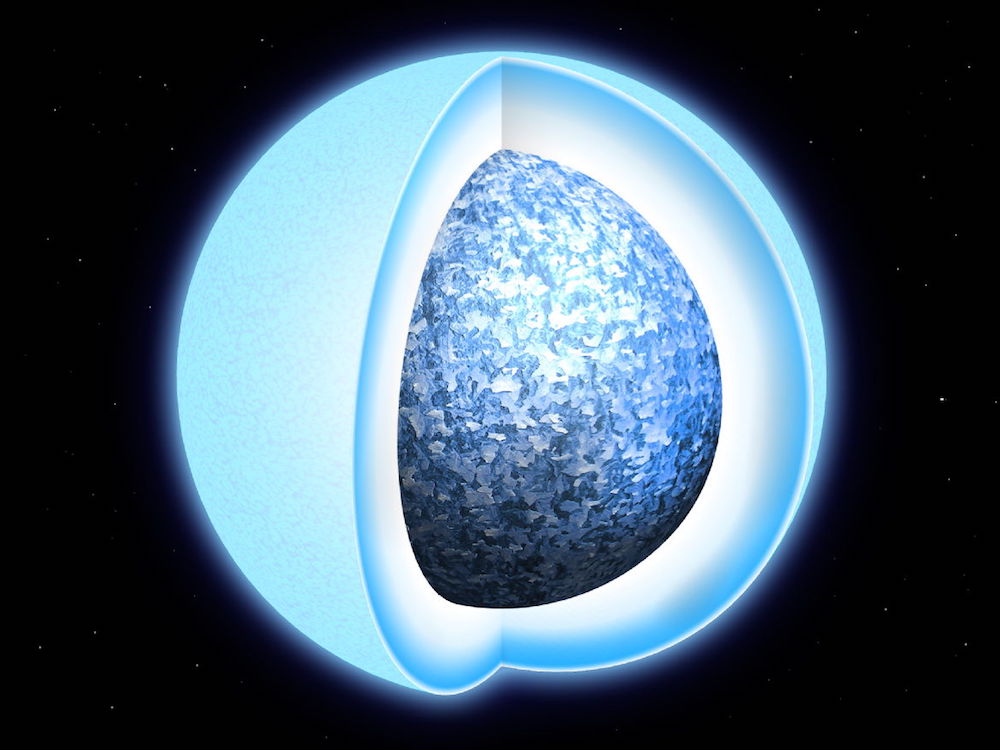Earth's Sun Will Turn into a Pure Crystal Ball Before It Dies

In a process not unlike human aging, most stars entering the final chapter of their lives tend to shrink, shrivel and slowly turn white. Astronomers call these cold, dense husks of once-mighty stars white dwarfs and, unlike humans, their dotage can last for billions of years.
In that time, stars with masses between about a tenth and eight times the mass of our sun burn up the last of their nuclear energy, shed their fiery outer layers and dwindle into ultracompact cores that pack about a sun's-worth of mass into a planet-size package. While this might sound like an unglamorous ending for a star, a new study published today (Jan. 9) in the journal Nature posits that white dwarfhood may be just the start of a beautiful new metamorphosis. [Shine On: Photos of Dazzling Mineral Specimens]
In a study of more than 15,000 known white dwarfs around the Milky Way, a team of astronomers from the University of Warwick in the U.K. concluded that dying stars don't just fizzle out of existence — they first turn into luminous crystal orbs.
"All white dwarfs will crystallize at some point in their evolution," lead study author Pier-Emmanuel Tremblay, an astrophysicist at the University of Warwick, said in a statement. "This means that billions of white dwarfs in our galaxy have already completed the process and are essentially crystal spheres in the sky."
If that's accurate, then Earth's sun itself — as well as an estimated 97 percent of stars in the Milky Way — are also destined to end their days as crystal orbs shimmering through the cosmos.
Gaia in the sky with crystals
For their new study, Tremblay and his colleagues used observations from the European Space Agency's Gaia satellite to analyze the luminosity and colors of about 15,000 known white dwarfs located within 300 light-years of Earth. They saw that an excess of stars seemed to share the same luminosities and colors, regardless of the stars' sizes and ages.
The uniform appearance of these stars suggested that the dwarfs had reached some sort of set phase in their development, and one that could span billions of years. Using models of star evolution, the researchers determined that these dwarfs had all reached a phase where latent heat was being released from their cores in large amounts, significantly slowing their cooling. And when a white dwarf cools enough, the authors wrote, the molten liquid at its core begins to solidify — in other words, the star begins turning to crystal.
Sign up for the Live Science daily newsletter now
Get the world’s most fascinating discoveries delivered straight to your inbox.
According to Tremblay, this study provides "the first direct evidence that white dwarfs crystallize," finally supporting a hypothesis first raised by scientists 50 years ago. If these findings are indeed accurate, they could give scientists reason to rethink the way they've been dating celestial objects. Because it can take a star many billions of years to reach white dwarf status, astronomers often use these stellar elder statesmen to come up with date ranges for galaxies and other celestial bodies in a given dwarf's neighborhood.
According to the new study, though, the heat released during a white dwarf's crystallization phase could slow the star's cooling by as many as 2 billion years. If that's the case, known white dwarfs may be billions of years older than thought. This complicates an already mysterious chronology; scientists aren’t sure exactly how long a dying star can remain a white dwarf before it ceases emitting light and heat altogether, thus becoming what some researchers call a "black dwarf." This theoretical endpoint of stellar evolution has never been observed, as scientists think it could take a star quadrillions of years to reach this state. At a nubile 13.8 billion years old, our universe is far too young to host such elderly suns.
Further research is required for scientists to better understand the life and death of the stars, and to hone their cosmic dating methods. Luckily, thanks to the Gaia satellite's extensive observations, there's an unprecedented number of known white dwarfs just itching to share the tales of their long, long lives.
"Before Gaia, we had 100 to 200 white dwarfs with precise distances and luminosities," Tremblay said. "Now, we have 200,000."
- Spaced Out! 101 Astronomy Images That Will Blow Your Mind
- 11 Fascinating Facts About Our Milky Way Galaxy
- Big Bang to Civilization: 10 Amazing Origin Events
Originally published on Live Science.

Brandon is the space/physics editor at Live Science. His writing has appeared in The Washington Post, Reader's Digest, CBS.com, the Richard Dawkins Foundation website and other outlets. He holds a bachelor's degree in creative writing from the University of Arizona, with minors in journalism and media arts. He enjoys writing most about space, geoscience and the mysteries of the universe.










